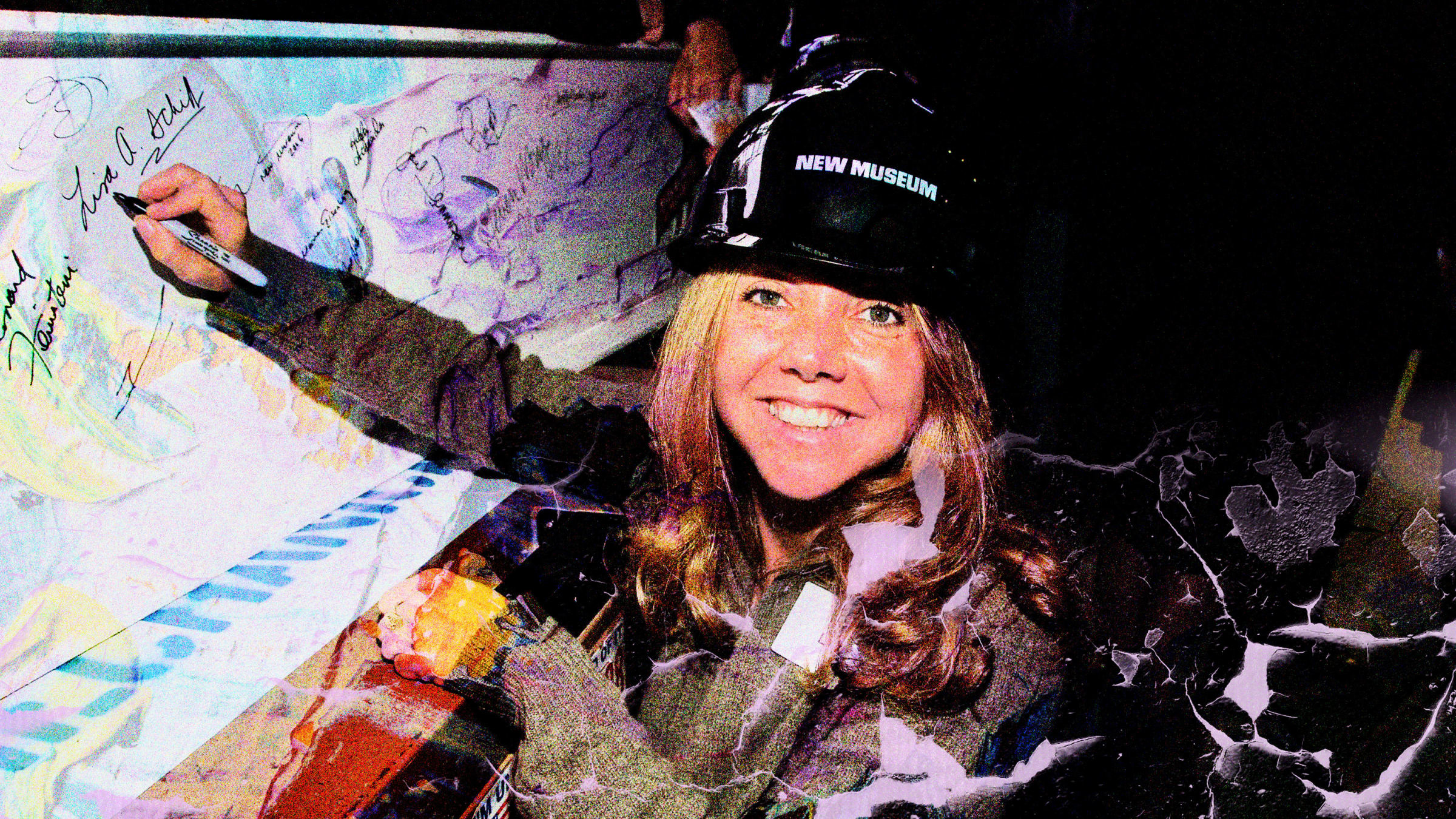Just months ago, New York art maven Lisa Schiff was basking in luxury as a consultant for the ultra-rich. The 53-year-old kept up with her clientele by living in a $25,000 a month apartment, splashing out on couture clothing, and sending her son to a pricey private school, according to documents filed in a lawsuit this month. Her clients included Leonardo DiCaprio and Sprinkles Cupcakes founder Candace Nelson, and she was a regular at glitzy society galas and hip art hangouts. At Art Basel in Miami Beach—where she sported rose-tinted glasses—she was lauded as “one of New York City’s top art advisers.”
Then, this month, it all fell apart.
In a dizzying fall from grace, Schiff was accused by a close friend and client of running a “Ponzi scheme” and misappropriating millions of dollars from art deals. Her website quickly disappeared from the internet, and on May 17, she filed a notice with New York Supreme Court that her business was defunct. Schiff’s offices in New York and London are now empty. Two lawyers say she could face criminal charges if the allegations against her hold up.
“I always thought of her as one of the good ones out there, and I think a lot of people did,” said Jason Patrick Voegele, a curator and art consultant based in New York. “And all this news that’s going on, it’s kind of like, whoa, wait a minute, maybe my perceptions have been misguided.”
Schiff did not respond to requests for comment and hasn’t weighed in with her own set of facts in court.
A former cheerleader raised in Miami, Schiff began her adult life in the staid world of academia. She earned an art history master’s from the University of Miami, according to a 2020 profile by the online marketplace Artsy, then started a doctoral program at the City University of New York, where she “read a shit ton of Marxist literature.” She later told CNN that she had planned to be a professor until “her parents cut her off and she had to make a living.”
Schiff started her art consulting business, SFA Advisory, in 2002, after spending time working in auction houses and elite galleries. “It was kind of ballsy. I had no idea what I was doing. I just couldn’t function in the system. I was always feisty and frustrated,” she later said. She paid a PR agency to promote her, which Artsy described as “an unusual move for an art advisor.”
Over time, Schiff became a fixture of the art world: She hosted panels at Art Basel, served on the board of major New York City museums, and offered expert commentary for The New York Times, Financial Times, Bloomberg News, and more. Celebrity photography agency Patrick McMullan sent snappers to her events, attended by well-known names like designer Nicole Miller and actor Will Kemp. She also grabbed headlines for her work with DiCaprio, who enlisted her to orchestrate multi-million-dollar art auctions for his environmental charity. “It was a huge treat,” she said of that gig. “He is 1,000 percent a real collector. He collects dinosaur bones, stuff from trips and travels, odds and ends.”
In 2019, she opened her first physical space in Tribeca, which combined her advisory firm with a concept store and exhibition space. The move was seen as a sign of Schiff’s staying power—she signed a 10-year lease—and of her intrepidness. A Financial Times profile called the opening of the space “unprecedented” and declared that Schiff was “disrupting the art advisory business.”
But there were signs of trouble even before this month’s drama. A spokesperson for the Bronx Museum told The Daily Beast Schiff resigned from the museum’s board of directors in 2020 for “personal reasons;” the New Museum said she had not been involved with one of their membership councils since 2018. She appears to have been taken off listings for the Swiss Institutes of Contemporary Art’s board as recently as this month.
Photo Illustration by Erin O’Flynn/The Daily Beast/Sylvain Gaboury/Patrick McMullan via Getty Images
A source familiar with the situation told The Daily Beast that Schiff lived a lavish lifestyle even when finances were tight.
“She always flew business, always had cars set up in advance—not even using Uber, but car services,” the source said. “Everything was VIP, first class, yet somehow she still had to look to borrow money from people or postpone payments.”
“It kind of seemed like the math wasn’t adding up,” the source added.
The source also said Schiff had a habit of mingling friendship with business, and of “leaning on friends who also were clients.” This person said they observed Schiff putting off payments to—and even borrowing money from—her wealthy clients.
“The fact that something like this happened to her in her inner circle wasn’t really shocking to me,” they said of the current cases. “It could have happened to someone else sooner—and maybe it did.”
Still, no one expected the bombshell claims that have been levied by her former close friends. The first lawsuit—filed on May 11 by real-estate heiress Candace Barasch and another Schiff client, Richard Grossman—claimed that, around New Year’s, Schiff brokered the sale of Adrian Ghenie’s oil painting The Uncle 3 at Sotheby’s in Hong Kong for $2.5 million. She remitted a small fraction of the proceeds, the suit alleged, but failed to follow through on the remaining $1.8 million. According to the complaint, when Grossman’s spouse confronted Schiff on May 8, she admitted she didn’t have their money “and then walked away.”
A week after filing the first suit, Barasch, her husband, and a trust set up for their kids filed a separate lawsuit outlining many more instances of alleged fraud. Among the most egregious: In 2020, Barasch allegedly wrote Schiff’s company a $650,000 check to purchase a bronze sculpture from the Gladstone Gallery in New York. But this May, after the first fraud lawsuit was filed, Barasch said she discovered that the gallery was still owed $252,000. In a second, similar case, Barasch claimed she wrote Schiff’s firm a $390,000 check in 2020 for another sculpture from the same gallery. This month, Barasch learned that the gallery never received any of those funds, she said. (The Gladstone Gallery did not respond to multiple requests for comment.)
In total, the complaint alleged, the Barasches paid Schiff or her companies more than $6.6 million over 18 months, but “much of” that money was instead used to pay for Schiff’s personal expenses, other debts, or acquisitions for different clients.
The Barasches said they didn’t catch on to Schiff’s alleged shenanigans because they had given her significant control over their collection, including inventory management, storage, and acquisitions.
In an interview with The Daily Beast, Leila Amineddoleh, a lawyer who specializes in art and cultural heritage law, appeared floored by the arrangement. “What’s shocking here is they didn’t just give her access to certain pieces of art under certain circumstances, but it seems like she had broad discretion to access their storage unit, to use their credit cards. I would never advise clients to do that.” (Amineddoleh emphasized that Schiff may dispute these allegations.)
In an interview with the Times last year, Schiff spoke about the financial vagaries of the art world.
“I tell new collectors: Art is not liquid. If you feel like you might need to get your money out for an emergency, do not collect art, because your transactable window is, like, two weeks long—unpredictable,” she said. “And when it’s not there, do not try to sell. Yet everybody does, and they hate it, and they’re furious.”

Photo Illustration by Erin O’Flynn/The Daily Beast/Neil Rasmus/Patrick McMullan via Getty Images
Amineddoleh noted that the first lawsuit against Schiff dropped just as the local art industry was commencing one of its busiest weeks of the year—the TEFAF New York Art Fair—where all of the opulence screams legitimacy. “I was there this week. They have oysters, you can get champagne, you see celebrities at these events. So people really get caught up in the glamor,” she said. “And they forget…there are criminals in the art world just like in any other area.”
Now, former business partners are struggling to make sense of Schiff’s possible demise—and what it signals about their industry. Voegele speculated that Schiff’s expenses—even those unrelated to her alleged personal spending habit—may have trapped her in a financial hole.
“I think this is a systemic problem in the art world where you make a certain name for yourself, and there’s certain expectations of you. And then the bills start rolling in…” he said. Voegele has witnessed art businesses pay off liabilities using money from other clients, he added—even if that money should have been earmarked for a different use. “I use the term ‘robbing Peter to pay Paul.’ I think that happens far more often than people are aware.”
Usually, however, these kinds of liquidity crises involve far smaller amounts of money than Schiff’s dispute, said Voegele, who recalled selling a few multiple pieces to her several years ago. (He said she always paid on time.)
Daniel Weiner, co-chair of the art law practice at Hughes Hubbard & Reed, attested that the industry is a natural target for fraudsters; massive deals are sometimes done in secret and wealthy buyers often operate through layers of advisers and LLCs. “Money plus trust plus opacity equals trouble,” he said. “No one counterfeits $1 bills. If there’s more money, then that attracts more people who can engage in misconduct.”
Weiner pointed to art dealers Inigo Philbrick and Larry Salander, and jewelry mogul Ralph Esmerian, as formerly respected figures in the industry whose reputations imploded after they were charged with separate instances of fraud. (Each of them received a prison sentence of at least six years.)
The downfalls always come as a shock, he said; many art world criminals “went to the best schools and wore the best clothes. But for whatever reason they crossed the line.”
Weiner added that, if the allegations against Schiff are true, she could be prosecuted—although she does not face criminal charges at the moment, and it is not clear whether law enforcement are even investigating her. As the Barasches depicted her conduct, it “sounds like fraud six ways from Sunday,” Weinere said. “You know, one or two examples [of misplaced funds], I think you could explain by miscommunication or temporary liquidity problems. But when you start to get this pattern of behavior like this, it’s really damning.”
According to Amineddoleh, financial disputes between collectors and their advisers aren’t unheard of, but they rarely involve someone as high-profile as Schiff. Many conflicts also remain private, she said, since the cost of litigation can easily outweigh the potential financial remedies and because wealthy collectors can’t stomach the hit to their reputation and ego: “They feel badly they were duped in some way.”
Schiff’s attorney said in a court filing that she will respond to the first lawsuit by June 15. But no matter the outcome, the damage to her reputation—and the industry—may be difficult to reverse.
“That’s the worst part of the whole thing,” said Voegele, the art consultant. “Whether she did this or not, the ripples of worry and the trust with art advisories and art consultants…That’s going to be a big problem.”

